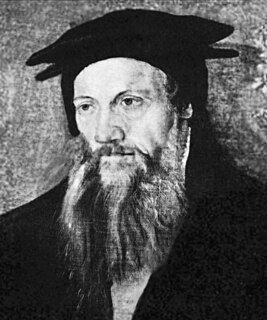Related Research Articles
George Abbot or Abbott was an English lay writer, known as "The Puritan", and a politician who sat in the House of Commons in two periods between 1640 and 1649. He is known also for his part in defending Caldecote House against royalist forces in the early days of the English Civil War.

Richard Zouch was an English judge and member of parliament from 1621 to 1624. Born at Ansty, Wiltshire he was educated at New College, Oxford and later married Sara, daughter of John Harte of Brill. He was elected Member of Parliament for Hythe in 1621 and later became principle of St. Alban Hall. During the English Civil War he was a Royalist and was appointed by Oliver Cromwell to a special commission of oyer and terminer. Zouch wrote extensive legal texts and was among the earliest systematic writers of International Law

Johann Albert Fabricius was a German classical scholar and bibliographer.

Conrad Gessner was a Swiss physician, naturalist, bibliographer, and philologist. Born into a poor family in Zürich, Switzerland, his father and teachers quickly realised his talents and supported him through university, where he studied classical languages, theology and medicine. He became Zürich's City Physician, but was able to spend much of his time on collecting, research and writing. Gessner compiled monumental works on bibliography and zoology and was working on a major botanical text at the time of his death from plague at the age of 49. He is regarded as the father of modern scientific bibliography, zoology and botany. He was frequently the first to describe a species of plant or animal in Europe, such as the tulip in 1559. A number of plants and animals have been named after him.

Pieter Burman, also known as Peter or Pieter Burmann and posthumously distinguished from his nephew as "the Elder", was a Dutch classical scholar.
Alexander Balloch Grosart was a Scottish clergyman and literary editor. He is chiefly remembered for reprinting much rare Elizabethan literature, a work which he undertook because of his interest in Puritan theology.

Thomas Gataker was an English clergyman and theologian.

George Vertue was an English engraver and antiquary, whose notebooks on British art of the first half of the 18th century are a valuable source for the period.

Richard Baxter was an English Puritan church leader, poet, hymnodist, theologian, and controversialist. Dean Stanley called him "the chief of English Protestant Schoolmen". After some false starts, he made his reputation by his ministry at Kidderminster, and at around the same time began a long and prolific career as theological writer. After the Restoration he refused preferment, while retaining a non-separatist Presbyterian approach, and became one of the most influential leaders of the Nonconformists, spending time in prison. His views on justification and sanctification are somewhat controversial and unconventional within the Calvinist tradition because his teachings seem, to some, to undermine salvation by faith, in that he emphasizes the necessity of repentance and faithfulness.

John Davies of Hereford was a writing-master and an Anglo-Welsh poet. He referred to himself as John Davies of Hereford in order to distinguish him from others of the same name, particularly the contemporary poet, Sir John Davies (1569–1626).

Sir Thomas Stanley was an English author and translator.

Sir George Scharf KCB was an English art critic, illustrator, and director of the National Portrait Gallery.

Gervase Babington (1549/1550–1610) was an English churchman, serving as the Bishop of Llandaff (1591–1594), Bishop of Exeter (1594–1597) and Bishop of Worcester in 1597–1610. He was a member of the Babington family and held influential offices at the same time as his cousin Anthony Babington was executed for treason against Elizabeth I as part of the Babington Plot.

Sir James Balfour, 1st Baronet of Denmilne and Kinnaid, of Perth and Kinross, Scotland, was a Scottish annalist and antiquary.
William Webster (1689–1758) was a British priest in the Church of England and a theological writer.

William Bates (1625–1699) was an English Presbyterian minister.

William Beveridge was an English writer and clergyman who served as Bishop of St Asaph from 1704 until his death.
George Benson was an English Presbyterian pastor and theologian who was noted for his publications on the Christian epistles.
John Gagnier (1670?–1740) was a French orientalist, resident for much of his life in England.
This article is about the particular significance of the year 1723 to Wales and its people.
References

- Chisholm, Hugh, ed. (1911). . Encyclopædia Britannica . 3 (11th ed.). Cambridge University Press. p. 553.
- McDayter, Mark. "Baxter, William (1650–1723)". Oxford Dictionary of National Biography (online ed.). Oxford University Press. doi:10.1093/ref:odnb/1739.(Subscription or UK public library membership required.)